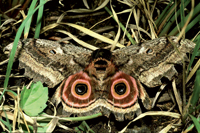Marvellous moth motif
One of the most stunning of the wonders in the insect world is on the Emperor Speckled Moth (Gynanisa maja) from southern Africa, a member of the silkmoth group. To scare predators away, its wings display this strikingly accurate rendition of a mammal’s face—even the sparkle in the pupils!
Many other day-flying silk moths have eye spots decorating their wings, but only the Emperor Speckled Moth has such an elaborate design.

Secular scientists do not even try to explain the details of how such a masterful living painting could have occurred, but they believe it happened somehow through natural processes—genetic accidents performed repeated ‘experiments’ (‘tinkering’1) with the wing decoration, subsequently validated or invalidated by natural selection. (Those patterns that more closely resembled a mammal predator would be more likely to frighten off marauding birds, thus increasing the moth’s chance of survival.)
Natural selection is a fact, but to produce such a coherent picture via random changes would have required an incredibly long time—far longer than even evolutionists are willing to accept. And random changes are the only way for natural processes to ‘create’ such a pattern; the moth cannot control the delicate and enormously complicated molecular reactions that produce the wing patterns, nor does it know what a mammal’s face looks like anyway. Its composite eyes are designed to focus on nearby objects, and to detect motion—distant objects would appear blurry.
The Emperor Speckled Moth is living evidence of God’s wonderful design and cries out in loud, clear living colour: ‘CREATION’.
Reference
- National Geographic 210(5):110–135, November 2006. Return to text.


Readers’ comments
Comments are automatically closed 14 days after publication.